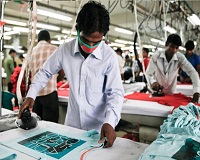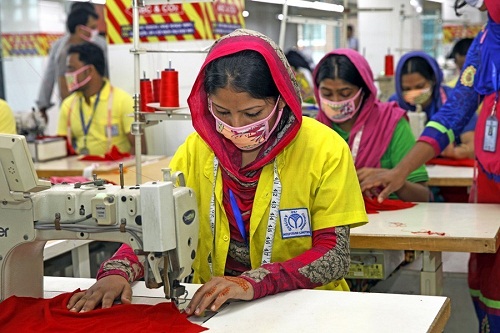"The recent Apparel Sourcing Show, hosted in Paris, noted that China's dominance of the global clothing manufacturing sector might soon come to an end. Bangladesh, with its lower production costs, will overtake China, with many Chinese manufacturers shifting their production facilities to the South Asian nation. As Michael Scherpe, President of Messe Frankfurt France points out, attendance at the 2018 show declined 2.6 per cent from the earlier event. However, still around 29,000 fashion aficionados visited the show's five dedicated display halls – Avantex, Leatherworld, Shawls&Scarves, Texworld and Texworld Denim. Focus on the textile micro-factory phenomenon."
 The recent Apparel Sourcing Show, hosted in Paris, noted that China's dominance of the global clothing manufacturing sector might soon come to an end. Bangladesh, with its lower production costs, will overtake China, with many Chinese manufacturers shifting their production facilities to the South Asian nation.
The recent Apparel Sourcing Show, hosted in Paris, noted that China's dominance of the global clothing manufacturing sector might soon come to an end. Bangladesh, with its lower production costs, will overtake China, with many Chinese manufacturers shifting their production facilities to the South Asian nation.
As Michael Scherpe, President of Messe Frankfurt France points out, attendance at the 2018 show declined 2.6 per cent from the earlier event. However, still around 29,000 fashion aficionados visited the show's five dedicated display halls – Avantex, Leatherworld, Shawls&Scarves, Texworld and Texworld Denim. Focus on the textile micro-factory phenomenon.
In addition to the hundreds of stands, daily conferences and catwalks shows also engaged the show's attendees. One such round-table conference, within Avantex – the event's dedicated high-tech and smart fibres zone – focused on the textile micro-factory phenomenon, a development that has been driven by growing demand for localised production facilities and more reactive supply chains.
One of the most high-profile contributors to this particular discussion was Christian Kaiser, Project Research Manager for the Deutsche Institute fürTextil und Faserforschung (DITF), one of Germany's largest textile research centres. He highlighted the role high-tech design systems had to play in the development of such micro-factories. The panel also discussed the impact a new generation of large-format inkjet printing systems – particularly with regard to polyester and pigment sublimation for cotton and mixed – had on creating flexible opportunities for small-batch production.
China retains a robust presence
Chinese companies retained a robust presence throughout the event, most notably via a memorable showcase of the work of a number of mainland fashion designers over on the Premium Brands Ready to Wear stage. One particularly dazzling sequined jacket came courtesy of the Ningbo-based Aiyimei Group, which employs 3,200 people across a range of disciplines, including garment making, textile printing / dyeing and knitting.
designers over on the Premium Brands Ready to Wear stage. One particularly dazzling sequined jacket came courtesy of the Ningbo-based Aiyimei Group, which employs 3,200 people across a range of disciplines, including garment making, textile printing / dyeing and knitting.
China Textile Information Centre (CTIC), a Beijing-based trade body, installed several outsized 'silent salesmen' booths, information points designed to showcase the mainland's many strengths across the garment manufacturing sector. Pre-eminent among these was the Fabrics China Trend Forum, a range of displays designed to position China as a global leader in innovative textiles manufacturing.
In addition, the Hong Kong Trade Development Council (HKTDC) hosted its own bespoke Hong Kong Pavilion. This year, it focused on six of the SAR's clothing businesses in particular – Asia Smart Industrial, Asiatex Enterprise, Come Base, Eto Knit Company, Hi-Style Manufacturing and the Yester Group.
China put in a particularly impressive show in the fashion accessories sectorwith Zhejiang Golden Point Textile attracting particular attention. The company now provides finished textiles to a number of leading international brands from our Shaoxing facility.
Emergence of Bangladesh
There were clear signs of Chinese manufacturers moving their production facilities out of China at the conference. Leading among these was the Hong Kong/Guangdong-based Yester Group.
Overall, Bangladeshi investment into the textile industry has propelled the country to be the second most preferred sourcing option, transforming the fortunes of many local businesses, including Zaber&Zubair Fabrics. The Noman Group company, one of the largest vertical operations in South East Asia, now outputsover 110 million metres of textiles every year.












